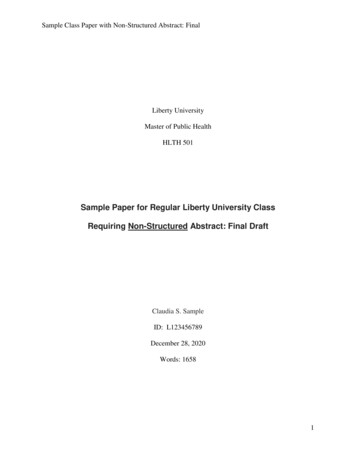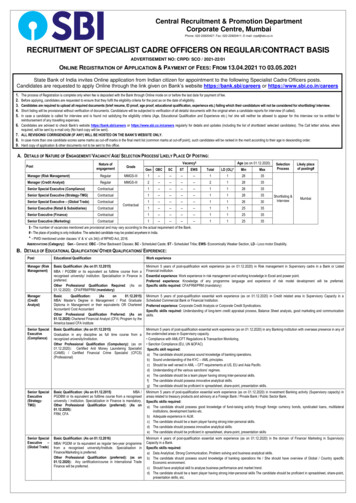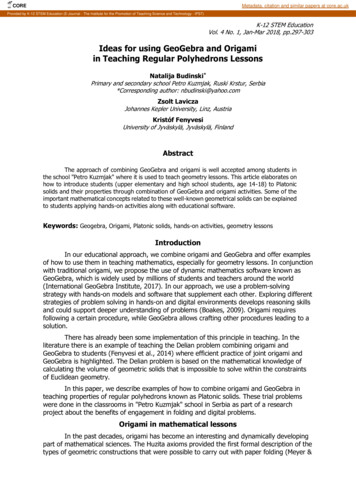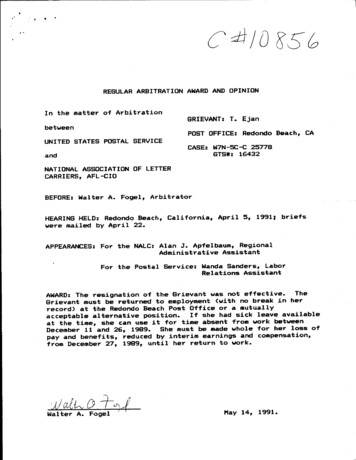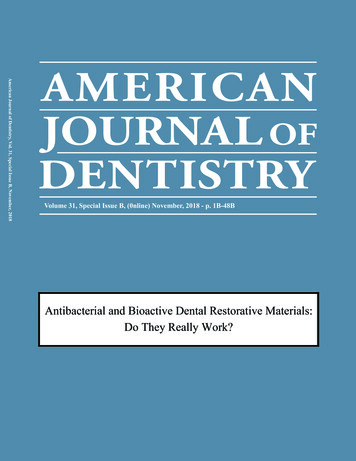
Transcription
American Journal of Dentistry, Vol. 31, Special Issue B, November, 2018AJD regular cover art(reversed with text in dark blue)Note – overall background PMS blue gray –PMS 5415Volume 31, Special Issue B, (0nline) November, 2018 - p. 1B-48BAntibacterial and Bioactive Dental Restorative Materials:Do They Really Work?
EDITORFranklin García-GodoyUniversity of Tennessee HSC, USAMANAGING EDITORKatherine J. García-GodoyEDITORIAL BOARDMichael C. AlfanoNew York University, USAThomas AttinUniversity of Zurich, SwitzerlandEugenio BrambillaUniversity of Milan, ItalyDaniel C.N. ChanUniversity of Washington, USAGordon J. ChristensenPractical Clinical Courses, USASebastian G. CiancioSUNY at Buffalo, USAGary A. CrimUniversity of Louisville, USAJaime CuryUniversity of Campinas, BrazilKevin J. DonlyUniversity of Texas HSCSA, USAAlbert J. FeilzerACTA, The NetherlandsJack L. FerracaneOregon Health & Science University, USAMarco FerrariUniversity of Siena, ItalyCatherine M. FlaitzNationwide Children’s Hospital, USARoland FrankenbergerUniversity of Marburg, GermanyRobert W. GerlachProcter & Gamble Co., USAReinhard HickelUniversity of Munich, GermanyM. John HicksBaylor College of Medicine, USAMark E. JensenUniversity of Tennessee HSCAndrej M. KielbassaDanube Private University, AustriaNorbert KrämerUniversity of Erlangen, GermanyIvo KrejciUniversity of Geneva, SwitzerlandJohn F. McCabeNewcastle University, UKPeter E. MurrayNova Southeastern University, USARaquel OsorioUniversity of Granada, SpainCornelis H. PameijerUniversity of Connecticut, USARade D. ParavinaUniversity of Texas HSC at Houston, USAJorge PerdigãoUniversity of Minnesota, USAJohn M. PowersDental Advisors, USAMark S. PuttIndiana University-Purdue University, USAJames C. Ragain, JrUniversity of Tennessee HSCHans-Jörg StaehleUniversity of Heidelberg, GermanyEdward J. Swift, Jr.University of North Carolina, USAJunji TagamiTokyo Medical and Dental University, USADaranee TantbirojnUniversity of Tennessee HSCFranklin TayAugusta University Health, USAManuel ToledanoUniversity of Granada, SpainBart Van MeerbeekUniversity of Leuven, BelgiumAntheunis VersluisUniversity of Tennessee HSCAnthony R. VolpePrivate consultant, USAAnn WennerbergGöteborg University, SwedenSTATISTICAL CONSULTANTDaniel L. JonesTexas A&M University, USAVolume 31, Special Issue B, November, 20182018 -- p.p. 1B1B –– cterial andand bioactiveAntibacterialbioactive dentaldental restorativerestorative materials:materials:DoDo theythey reallyreally work?work?ForewardForewardD.C.N. Chan & A. SadrD.C.N. Chan & A. Sadr2B2BAntibacterial and bioactive dental restorative materials: Do they really work?Antibacterialbioactiverestorative materials: Do they really work?D.C.N. Chan, andA.K.H.Chung dental& A. ParanjpeD.C.N. Chan, A.K.H. Chung & A. Paranjpe3B3BIntroduction ArticleIntroduction ArticleReview ArticlesReview ArticlesAntibacterial dental restorative materials: A review.Antibacterialdentalmaterials: A review.L. Chen, B.I. Suh& restorativeJ. YangL. Chen, B.I. Suh & J. YangDevelopment of an antibacterial bioactive dental adhesive: SimplicityDevelopmentof an antibacterial bioactive dental adhesive: Simplicityand innovation.andinnovation.Y. Fujimura,D. Weerasinghe & M. KawashimaY. Fujimura, D. Weerasinghe & M. KawashimaSpecial Issue lactivity, and biocompatibility of new antibacterialdental monomers.Synthesis,antibacterial activity, and biocompatibility of new antibacterialY. Wang,S. Costin, J-f. Zhang, S. Liao, Z.T. Wen, T. Lallier, Q. Yu & X. Xudentalmonomers.Y. Wang, S. Costin, J-f. Zhang, S. Liao, Z.T. Wen, T. Lallier, Q. Yu & X. XuDental cements: Bioactivity, bond strength and demineralization ivity, bond strength and demineralization progressionA. Turkistani,S. Islam, Y. Shimada, J. Tagami & A. Sadrrestorations.aroundA. Turkistani, S. Islam, Y. Shimada, J. Tagami & A. SadrReactions: Antibacterial and bioactive dental restorative materials:Do they reallywork?Reactions:Antibacterialand bioactive dental restorative materials:D.C.N.Chan,W.Hu, K-H. Chung, R. Larsen, S. Jensen, D. Cao, L. Gaviria,Do they really work?J.L. Ong,K. WhangT. EiampongpaiboonD.C.N.Chan,W. Hu,&K-H.Chung, R. Larsen, S. Jensen, D. Cao, L. Gaviria,J.L. Ong, K. Whang & T. EiampongpaiboonAntibacterial-containing dental adhesives’ effects on oral pathogens andon Streptococcus mutans biofilm: Current perspectives.Antibacterial-containing dental adhesives’ effects on oral pathogens andC.B. André, D.C.N. Chan & M. Gianninion Streptococcus mutans biofilm: Current perspectives.C.B.André,D.C.N. ionsChanfrom& M.Giannini monosodium titanates for dentalReleaseof calciumparticulatemineralization applicationsReleaseof or dentalJ.L. Drury,Y-W. Chen,Plancich,K.M.L.Taylor-Pashow,D.T. Hobbsmineralizationapplications& J.C. WatahaJ.L. Drury, Y-W. Chen, B.J. Plancich, K.M.L. Taylor-Pashow, D.T. Hobbs& J.C. Wataha6B6B13B13B17B17B24B24B32B32B37B37B42B42B
Special Issue ForewardOn behalf of the University of Washington School ofDentistry Department of Restorative Dentistry, we wouldlike to welcome you to the proceedings publication on“Antibacterial and Bioactive Dental Restorative Materials:Do They Really Work?” We believe it was high time thatsuch an event took place to focus on and discuss some of thebasic questions related to the topic. We made a special effortto invite presentations from a diversity of research backgrounds. The symposium, supported by the Dental MaterialsGroup under the same title, was held during the 94th GeneralSession & Exhibition of the IADR in Seoul, Korea on June24, 2016, and provided a valuable opportunity for researchscientists, industry specialists, clinicians and academicians toshare experiences.We would like to thank the International Association forDental Research and the Dental Materials Group forproviding such a platform. We are especially grateful to themany experts who shared their knowledge via presentation,discussion and feedback during the proceedings.We also thank all the participants and reviewers of theSpecial Issue and the IADR for allowing us to conduct theSymposium in the first place. Such a large-scale internationalproject is impossible without the support and help fromorganizations, foundations, and sponsors. We are verygrateful to WDS Endowment, Japanese Society for Promotion of Science, Bisco Inc., Cao Group, and KurarayNoritake Dental for their financial support towards thepublication of this Special Issue. The American Journal ofDentistry editorial staff also provided invaluable suggestionsand help to make this Special Issue a reality.With the limits of time and resources, we are certain thatseveral topics and experts have been left out and there arestill many unanswered questions. Our goal was to initiate afruitful and rewarding exchange with this proceedings. Welook forward to a successful outcome and continuedresearch, discussion, and debate on the subject, with all ofour esteemed global colleagues.Daniel C.N. ChanAlireza SadrUniversity of Washington School of DentistrySeattle, Washington
Special Issue IntroductionAntibacterial and bioactive dental restorative materials: Do they reallywork?DANIEL C.N. CHAN, DMD, DDS, ALBERT K.H. CHUNG, DDS, PHD & AVINA PARANJPE, BDS, PHDABSTRACT: Purpose: This proceedings reviews current antibacterial and bioactive dental materials and new agents indevelopment. Methods: Experts from across academia, industry and clinical practice were invited to present, discuss,and work together to develop solutions to the challenge of formulating and applying antibacterial dental materials in asymposium in Seoul, Korea in June, 2016. (Am J Dent 2018;31:3B-5B). : Dr. Daniel Chan, Department of Restorative Dentistry, University of Washington School of Dentistry, Box 357456,Seattle, WA 98195-7456, USA. E- : dcnchan@uw.eduIntroductionThe publication of the symposium proceedings is verytimely. The National Institute of Health reports that bacteriagrowing as a biofilm cause 80% of infections in the body.Biofilms at the margin of an existing restoration give rise tosecondary caries (NIH).1 One approach for overcoming thedevelopment of dental biofilms and secondary caries is todevelop antibacterial and bioactive dental restorative materials.This proceedings reviewed current dental materials and newagents in development. We invited experts from acrossacademia, industry and clinical practice working together todevelop solutions to this challenge.studies5 have shown that sub-lethal doses of antibiotics caninduce bacterial resistance and counteractively actually enhancebiofilm formation. The potential negative consequences ofbacterial resistance to antibiotics are dire because they put all ofsociety at risk.The question of whether it is more advantageous to bebioactive or antibacterial probably will never be settled.Usually dental bioactive materials can improve mechanicalintegrity and offer protective bioactivity e.g. in the form offluoride release. One must remember that not all bacteria arebad, and to be antibacterial indiscriminately may cause moreharm than good.Bioactive or antibacterial?Bioactive and antibacterial strategies - Metal or non-metalbased?The first paper (Chen et al2) sets the tone of the proceedings. This current manuscript and others by the same grouplooked at both bioactive and antibacterial materials. The termsbioactivity and bioactive material both have recently emergedin the dental literature. On the surface, bioactive is defined ashaving a biological effect. As such, all dental materials fit intothat category. The term bioactive material appears to haveoriginated with Dr. Larry Hench, the developer of the calciumsilicophosphate glass.3 Drury et al4 (in this Special Issue) didtouch on the calcium-mediated mineralization or re-mineralization and the fact that particulate MST-Ca(II) complexesexhibit sustained release of calcium, and that release might becustomized by conditions of pH and ionic strength. Regrettably,bioactive glass is a topic we hardly explored in this symposium.On the other hand, an antibacterial is an agent that killsbacteria or stops their growth. The determination of theantibacterial activity is described in international norms. Not alldental materials can be antibacterial.In the oral cavity, mixed microbial biofilms can accumulateon hard and soft tissue, and are involved in the pathogenesis ofcaries and periodontitis. A biofilm is an accumulation ofbacteria, fungi, or protozoa on solid surfaces. Two popularapproaches in dentistry to prevent biofilm formation are: (A) todesign a biomaterial that slowly releases an agent that is lethalto approaching bacterial cells; and (B) to develop a nonadhesive surface by modifying the surface chemistry ofrestoration materials. Various chemical agents can affectbacterial adhesion indirectly by disrupting bacterial cellmetabolism. Numerous materials have been impregnated withvarious antibiotics only to have most of the agent released overa very short time, thus providing no long-term effect. RecentTwo papers6,7 (in this Special Issue) dealt with developmentand synthesis of new antibacterial monomers. Both new agentsare organic in nature and can be classified as non-metal. MDPDis commercially available and much has been published onMDPD. Fujimura6 gave us a historical perspective and servesas an excellent blueprint for translation of basic science fromlaboratory to clinical use.Wang et al7 presented a small library of antibacterial dentalmonomers based on quaternary ammonium salts. Quaternaryammonium polyethylenimine (QAS-PEI) nanoparticles (NPs)have been incorporated into restorative materials to improveantibacterial activity and further reduce adverse effects onmechanical properties.3 Incorporation of QAS-PEI NPs intodental resin composites at 1 wt% concentration has beeneffective against Streptococcus mutans (SM) as well as againstbiofilm formation in vivo.However, given the increasing resistance of bacteria to organic antibacterials, metal-based antibacterials are a promisingalternative. Our group here at University of Washington took adifferent approach. We looked at metal-based antibacterialssince metal-based antibacterials such as silver and zinc are anattractive alternative to antibiotics. Metal ions have chemicalproperties that inhibit bacterial growth. The unique binding,coordination, and redox properties make development ofbacterial resistance less likely, and predict effectiveness acrossa broad bacterial spectrum. Unfortunately, development of newmetal-based antibacterials has been severely impeded due toprevious controversies and fears. If systemic toxicity could belimited and therapeutic indices were optimized, metal ions andtheir associated compounds could emerge as a new powerfulclass of antibacterial agents.
Fig. 1. Possible applications of dental materials in terms of bioactivity include incorporatbase and liner. In addition, they can be used inside an endodontic sealer or as coating for im4B Chanet al figuresChanOverviewAmerican Journal of Dentistry, Vol. 31, Special Issue B, November, 2018Fig. 2. Gold-titanate is a promising antibacterial nanoparticle material with alight sensitivity side-effect. Its use thus is limited to a thin layer as adhesiveFig.Possible applicationsdentalmaterialsin termsof bioactivityinclude include(A) orincorporationas a sealer insidecanal (B).materials,In terms oftheits compatibilitywith or as part oFig.1.1.Possibleapplicationsofofdentalmaterialsin termsof bioactivityintothetherootrestorativeadhesive systemincorporationthe restorativematerials,theinsideadhesiveor as partof or astitanates,as an implant coating can also be entertained.baseand liner. intoIn addition,they canbe usedan systemendodonticsealercoating applicationfor implants.a base and liner. In addition, they can be used inside an endodontic sealer oreliminationany residualbacteriaremainingpost-instru-which allows ioFig.2. Anatomyofof S-PRGfiller. It formsby a typeof stable glass-ionomer,as coating for implants.mentation.The most recent addition to the growing list of metal-basedCalcium hydroxide is routinely placed as an inter-appointantibacterials are our gold-titanate nanoparticles. Our team hasment intracanal medicament for non-surgical endodonticdeveloped micro-particulate metal-titanate complexes as a newprocedures. Despite efficacy of calcium hydroxide, thisclass of antibacterial agents. The micro-particulate gold (III)medicament has some limitations in its antimicrobial efficacyloaded titanate complexes inhibit growth of oral bacteria atand due to the fact that certain bacteria can withstand a highmicro molar concentrations. We have shown that nanopH environment.particulate metal-titanate complexes are even more effectiveOther alternatives to calcium hydroxide have beenthan micro-particulate complexes at inhibiting oral bacteriainvestigatedand used. Examples of historic medicaments aregrowth as these nano-particulate complexes have a significantlyphenoliccompounds,essential oils, aldehydes, halogens, andgreater surface-to-volume ratio, resulting in more effective ion8,9quarternaryammoniumcompounds. The use of these materialsexchange characteristics.has been discontinued due to their cytotoxicity and limitedcurrentapproachto incorporategold-titanateFig. 2.OurAnatomyof S-PRGfiller.isIt formsby a type ofthestableglass-ionomer, whichallows ionrelease andrecharge aveand may be usednanoparticles in adhesive systems because of manufacturingas intracanal medicaments, however they may produce resistantavailability issues, but in the long term, gold-titanate nanoparmicrobes and cause host sensitization. Therefore, their routineticles may also be incorporated into restorative materials asuse is not recommended. Steroids that have been used asfillers, or as coating on implant systems.10 Additionally, beintracanal medicaments can prevent the inflammatory responsecause these complexes are not organic, degradation is not anand subsequent pain. However they have limited antimicrobialissue and thus they can have long-term effectiveness, and alsoefficacy. Due to these reasons, antibiotics and steroids are notmay be less likely than organic antibacterial agents to contriroutinely placed.bute to bacterial resistance.The antimicrobial activity of gold nanoparticles (AuNPs)Wang et al7 and Giannini & Andre11 (both in this Special Fig.Anatomyof S-PRGforms by a type ofandstableGram-negativeglass-ionomer, which allows iohas3.beenstudiedin filler.both ItGram-positiveIssue) evaluated a few species of bacteria. It will be ideal tobacteria such as Staphylococcus aureus, Escherichia coli andanalyze a standard microbial mixed culture such as the onePseudomonas aeruginosa. Based on the bacterial protein assay,developed by Guggenheim12 and is considered by the researchnano-sized monosodium titanate (nanomonosodium titanate)community as a “model” of dental caries microbial flora.nMST-Au(III) showed the best effectiveness among titanatesand gold-titanates to decrease bacterial protein concentrations.A Univeristy of Washington Master’s thesis study13 examinedthe efficacy of gold-titanates on E. faecalis when used inRegardless of the types of materials, clinicians would evenintracanal medicament separately or in addition to calciumtually hope to apply the science and technology in real lifehydroxide and compared it with calcium hydroxide alone.situations.Basedon thefiller.discussionsIssue’sarticles,mostFig.3. Anatomyof S-PRGIt forms inbythisa typeof stableglass-ionomer,whichallows ion itreleaseand yetrechargeto take place.Unfortunately,cannotbe concludedthat gold-titanateof the applications seem to be focused on usage as restorativenanoparticles have antimicrobial efficacy against Gram-positivematerials, cements, and adhesives (Fig. 1a-d). We will attemptE. faecalis, most likely due to insensitivity of culturingto expand the discussions to root canal sealers and bioactivetechnique. The study did find that gold-titanate nanoparticlesdenture resins. Another important area not to be forgotten ismixed with sterile water or added to calcium hydroxide leaveimplant coating, especially when usage of implants is on theresidual crystals in the canal system, which may occlude therise and peri-implantitis is getting more common.dentin tubules and bacteria (Fig. 2).Root canal sealersBioactive fillers in denture resinApplications of antibacterialrestorative materialsandbioactivedentalSuccessful endodontic treatment depends on the effectiveness of the cleaning and shaping of the root canal system. Anyremaining tissue, bacteria, or debris can contribute toendodontic failure. Elimination of bacteria from the root canalsystem can be done via chemomechanical debridement andalso placement of intracanal medicament for reduction andMuch attention has been paid to the development of directdental materials that are antibacterial. Surface pre-reacted glassionomer fillers (S-PRG) are a newly introduced bioactivematerial and is of high potential interest to address the problemof caries in denture-wearing populations. S-PRG fillers are anovel class of particle that can be incorporated into resinous
American Journal of Dentistry, Vol. 31, Special Issue B, November, 2018Antibacterial & bioactive materials 5Bimplantitis, which is caused by the same bacterial biofilmformation that also causes caries and periodontal disease.Newer studies are looking at affecting bacterial adherence toimplants by modification of the surface topography. Silvernanoparticles have been used on surfaces modified to create acombination of silver, titanium dioxide and hydroxyapatite(HA) nanocoatings. Coated implants were found to have bothantibacterial properties and HA biocompatibility and did notseem to be compromised (Fig. 1e). We found this to be ve
Antibacterial and bioactive dental restorative materials: Do they really work? DANIEL C.N. CHAN, DMD, DDS, ALBERT K.H. CHUNG, DDS, PHD & AVINA PARANJPE, BDS, PHD ABSTRACT: Purpose: This proceedings reviews current antibacterial and bioactive



![[Page 1 – front cover] [Show cover CLEAN GET- AWAY 978-1 .](/img/13/9781984892973-6648.jpg)




